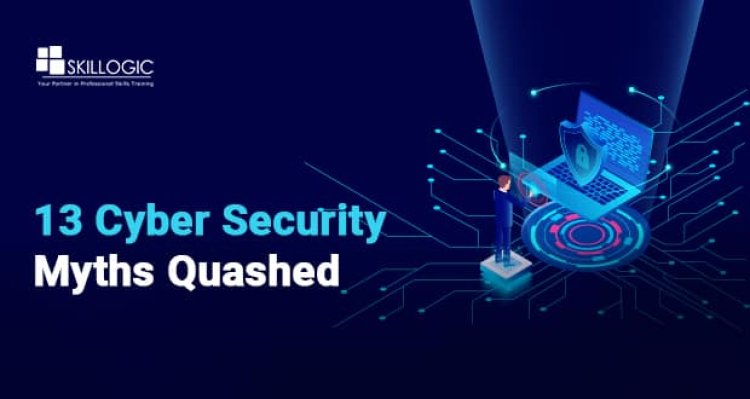13 Cyber Security Myths Quashed

In today’s world, someone is hacked every 32 seconds. Cybercrime is increasing at an alarming rate. The impact of cybercrime has expanded dramatically as the Internet has offered up a variety of opportunities and possibilities for people to consume and access information as well as communicate, with cybercriminals profiting from a bigger attack surface.
How can you protect yourself from cybercrime?
Cyber security has become a necessary component of any business. Because of the prevalence of unlawful hacking nowadays, the need to protect your data from outsiders has grown. Every organisation that wishes to thrive, regardless of its type, size, scope, or industry, must be ready to defend and safeguard its critical data at all times. Cybersecurity’s goal is to keep people safe online.
The global cyber security market is foreseen to get as far as USD 366.10 billion by 2028, with a CAGR of 12.0% over the forecast period, according to Globe Newswire.
Despite the rising focus on company security, certain cybersecurity myths and misconceptions all too often impede organisations from implementing the necessary level of technology protection. Here are some of the most prevalent cybersecurity myths that need to be debunked in order to ensure that you’re approaching and minimising your cybersecurity risk effectively.
- Having sophisticated technological aid is equivalent to being safe
Many businesses believe that by investing in high-end security technologies and solutions, they can create an impenetrable barrier between their networks and cybercriminals. Positioning, keeping track of, maintenance, and unification with overall security operations determine how effective security technologies and solutions are.
- Regular penetration tests are enough
A penetration test, on the other hand, is ineffective unless the organisation can manage and fix the vulnerabilities and security flaws uncovered during the test.
- Being compliant with industry standards helps
Being obedient does not imply that you are safe from threats. Organizations must examine if the regulations are significant enough and whether the breadth of the regulations encompasses all critical systems and data.
- Security through third party assistance
Come what may the capabilities and certifications of the security provider, you have a legal and ethical responsibility to recognise your company’s threats, how to handle them, and secure important assets are.
- Security is only needed for cyber devices and applications
Insider threats should be kept at bay, as not all crimes happen through the internet. Using infected disks or drives can impair systems and important files or folders to be vitiated.
- Cyber threats do not pose challenges to companies having strong security precautions
Cyberthreats are becoming more sophisticated and complex all the time, therefore businesses must always strive for cybersecurity. The goal is to create a strategic security posture that allows you to respond rapidly to a security issue and mitigate it before it causes significant damage.
- Only the IT departments take the security measures
Because a security compromise can have far-reaching and long-term consequences for the entire company, true cyber Security readiness is everyone’s duty.
- Our company is thoroughly secure
Cyber Security is a continuous process rather than a finished product. Cyberattacks get more clever, imaginative, and sophisticated over time, putting your company at risk. We need to be absolutely up-to-date in terms of monitoring the systems and ensuring that any alleged crime does not occur.
Watch this video: Biggest Cyber Attacks in the World
- Having strong passwords prevent cyber crimes
Having strong passwords is the first, but far from the only, step toward cyber security. A multi-layered defence is included in a good security system. Organizations must use two-factor authentication and conduct frequent data audits.
- Small and Medium-sized enterprises are least affected by cyber threats
This is a fallacy that has to be quashed right away, as statistics reveal that the majority of cybercrime targets small and medium-sized organisations. Small firms frequently lack modern security software and trained security personnel, making them a more vulnerable target for fraudsters.
- All cyber-attacks are from outside the organization
As a point of fact, external sources are responsible for the bulk of cyber dangers and crimes, but not all. Insider assaults are another common source of cybercrime. Insider risks provide a higher security risk than outsider threats due to employee incompetence, ignorance, and malevolent behaviour.
- Installing an anti-virus app can prevent cyber crimes
Anti-malware and anti-virus software might be useful, but they are often the source of viruses on your computer or phone. In order to achieve full-fledged cyber Security, the company must have a comprehensive cybersecurity strategy that addresses all aspects of the problem.
- It is quite simple to determine whether or not the systems have been hacked
It can take months, if not years, to determine whether sensitive data is at risk. Modern malware strains are increasingly more evasive and difficult to detect.
Refer the article to know the Cost of Ethical Hacking Certification in 2022.
Conclusion
Cybersecurity myths are a major problem in today’s digital world because they allow companies to ignore real threats by lowering their guard, allowing cybercriminals to cause havoc.
Knowing that “cybersecurity myths are only illusions” is the first step toward achieving the proper cybersecurity maturity level and, ultimately, defending your organisation to the required degree.
Join SKILLOGIC Cyber Security Training, which is accredited by EC-Council, CompTIA and IIFIS, if you want to learn more about the cybersecurity domain.
Check out this to know Ethical Hacking Course
Watch this video: Ethical Hacking Course Introduction

0
12891